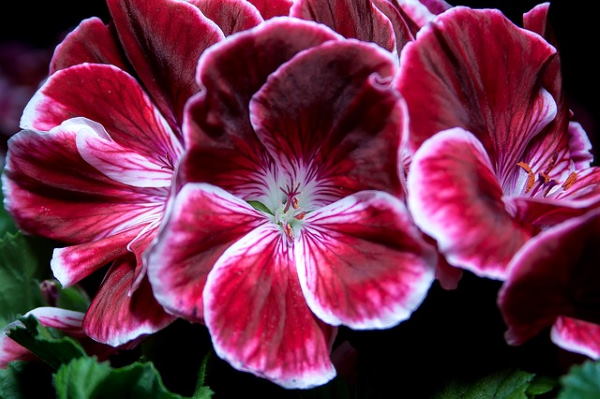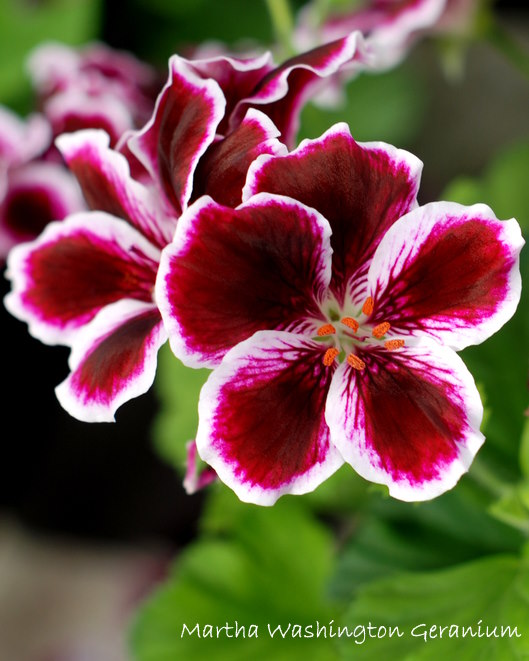Martha Washington Geranium Care
Martha Washington geranium gets its name from a once-popular cultivar. Although newer Pelargonium hybrids outshine 'Martha Washington', the name stuck. Today, that early cultivar has been replaced by more vigorous hybrids, with a wide range of spectacular flowers to choose from. These hybrids are also commonly known as Regal Geraniums.
 Big, velvety red and white flowers make this Pelargonium a stand-out. Image Source
Big, velvety red and white flowers make this Pelargonium a stand-out. Image SourceGet to Know Martha Washington Geraniums
With origins in South Africa, Pelargonium domesticum is a large group of complex hybrids. All have naturally branching, upright stems and dark-green, crinkled leaves.
Thick, succulent flower stems bear clusters of flat-petaled flowers. P. domesticum flower colors include pink, white, red, maroon, and purple -- in many captivating combinations. The top 2 petals often have a bolder color or a contrasting pattern.
How big do Martha Washington geraniums get? You can expect them to reach a height around 1-2 ft (30-60 cm).
You'll find these hybrid geraniums for sale in late winter or early spring, when they're in bloom. Many good cultivars of Pelargonium domesticum are available to choose from. Here are a few...'Maiden' varieties are compact, making them ideal for a sunny windowsill. 'Pompeii' is another compact plant, featuring stunning, nearly black petals edged in white. 'Carisbrooke' has big, pink flowers splashed with dark red.
Martha Washington geraniums bloom in late winter. If you're growing geraniums indoors, you'll need to give them a little help with the seasons...a rest in summer and a cool autumn will make them set flower buds.
How to Make Your Martha Washington Geranium Re-Bloom
- Cut it back. In summer, after flowering stops, cut plant back to 4-inch stems (10 cm).
- Repot. After flowering, repot your plant just to give it fresh soil. Geraniums bloom best if slightly pot-bound, so you can keep it in the same pot. Just be sure it has drainage holes to prevent overwatering -- geraniums don't like their feet wet.
- Give it a rest. Allow the plant to rest for the summer. Water sparingly and stop fertilizing during this rest. Keep it in indirect light.
- Cool it off. Give your Martha Washington geranium 2 months of cool temperatures to set flower buds. For the "cooling off" period, move your plant outside in fall when the nighttime temperature drops to 50°F/10°C. Or you can keep it in a cool basement or garage, where it will get plenty of indirect light. Resume normal watering and fertilizing during this cool treatment.
After following the steps above, you should see flower buds midwinter, and enjoy beautiful blooms in February or March.
 Photo credit: JenD / istockphoto
Photo credit: JenD / istockphotoIndoor Martha Washington Geranium Care
Light: Bright light
Water: Water thoroughly, and allow surface of soil to dry between waterings. Cut back on watering after flowering, but don't allow the roots to dry out completely. Brown spots on leaves are caused by a fungus. Cut off affected stems and leaves. Treat your plant with a fungicide if needed.
Humidity: Average room (around 40% relative humidity). Indoor air can become extremely dry in winter, causing brown leaf tips. Discover easy ways to raise the humidity for your houseplants.
Temperature: Winter through summer, normal room temperatures (65-75°F/18-24°C). In fall, 2 months of cool nights (50°F/10°C) will trigger flower buds.
Soil: Peat-based soilless mix
Fertilizer: Feed every 3 weeks fall through spring with a high-phosphorus liquid fertilizer diluted by half.
Propagation: Take stem cuttings in spring and root in fresh potting mix.
Problems, Answers and Special Helps
No blooms? Don't over-pot -- Pelargoniums bloom best if slightly pot-bound. Are you trying to get your houseplant to bloom the second year? It needs a cool rest (see "Re-blooming" steps above).
Lots of new leaf growth, but no flowers? You may have over-fertilized or used a high-nitrogen fertilizer that will make Martha Washington Geraniums grow lots of foliage, rather than flowers. Switch to a high-phosphorus fertilizer.
Deadhead spent flowers. This simple task not only makes your houseplant look better, it promotes more blooms.
Watch for spider mites. Dry-looking, yellow-stippled foliage with webbing between the leaves and stems are signs of spider mites. They can do a lot of damage, then move on to your other indoor plants. Isolate an infested houseplant and treat it right away.
Brown circles on leaves may be caused by bacterial leaf spot. If only a few leaves are affected, cut them off. Prune off entire stems, if necessary. You can use a fungicide to control the problem; if the fungus doesn't improve, dispose of the plant.


